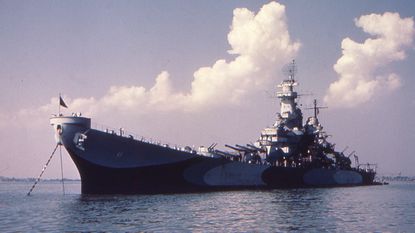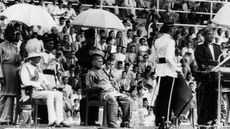7 August 1946: Turkish Straits crisis reaches its climax
A row over who was allowed to sail through the Dardanelles and the Bosphorus led to a stand-off between the USA and the USSR.


For the Soviet Union, the Turkish Straits could not have been more important. Since ancient times, the narrow bodies of water that make up the Bosphorus and the Dardanelles via the Sea of Marmara held enormous strategic importance both militarily and in terms of trade. The only way the Soviet navy could get from its Black Sea ports to the Mediterranean and the wider world was through the straits.
In 1936, the Soviet Union, along with several other regional and world powers, signed the Montreux Convention. It agreed that only ships from countries bordering the Black Sea could use the straits and it was up to neutral Turkey to police it. This, however, wasn't enough of a guarantee.
With the Second World War out of the way, Soviet deputy premier Lavrentiy Beria declared that a swathe of eastern Turkey close to the Black Sea belonged to Georgia, then part of the Soviet Union. It had been stolen, he said, by the Turks during the days of the Ottoman Empire. Moscow also complained that ships not from the Black Sea had been allowed to pass through the straits in violation of the convention.
Subscribe to MoneyWeek
Subscribe to MoneyWeek today and get your first six magazine issues absolutely FREE

Sign up to Money Morning
Don't miss the latest investment and personal finances news, market analysis, plus money-saving tips with our free twice-daily newsletter
Don't miss the latest investment and personal finances news, market analysis, plus money-saving tips with our free twice-daily newsletter
For the Americans, this confirmed their worst fears of Soviet expansionism. President Truman decided that the Soviet Union had to be contained, leading to the Truman Doctrine. In April 1946, the huge American battleship USS Missouri arrived in the straits, conveniently bearing the ashes of the deceased Turkish ambassador. The Soviet Union smelt a rat.
The crisis reached a head on 7 August 1946, when the Soviet Union handed Turkey a note stating that it had breached the Montreux Convention and a new treaty was needed. A Soviet military build-up followed.
Fearing Soviet designs on the straits, Britain and the United States declared their support for Turkey and a naval taskforce was dispatched to the region. Moscow backed down, and under protest, withdrew its demands for a renegotiation of the convention.
Turkey abandoned its policy of neutrality in accepting aid from the United States, and in 1952, joined Nato. With the death of Joseph Stalin the following year, the Soviet Union dropped its territorial claims and relations with Turkey began to thaw.
Chris Carter spent three glorious years reading English literature on the beautiful Welsh coast at Aberystwyth University. Graduating in 2005, he left for the University of York to specialise in Renaissance literature for his MA, before returning to his native Twickenham, in southwest London. He joined a Richmond-based recruitment company, where he worked with several clients, including the Queen’s bank, Coutts, as well as the super luxury, Dorchester-owned Coworth Park country house hotel, near Ascot in Berkshire.
Then, in 2011, Chris joined MoneyWeek. Initially working as part of the website production team, Chris soon rose to the lofty heights of wealth editor, overseeing MoneyWeek’s Spending It lifestyle section. Chris travels the globe in pursuit of his work, soaking up the local culture and sampling the very finest in cuisine, hotels and resorts for the magazine’s discerning readership. He also enjoys writing his fortnightly page on collectables, delving into the fascinating world of auctions and art, classic cars, coins, watches, wine and whisky investing.
You can follow Chris on Instagram.
-
 Adidas, Nike or Jordans - could collectable trainers make you rich?
Adidas, Nike or Jordans - could collectable trainers make you rich?The right pair of trainers can fetch six figures. Here's how you can start collecting vintage Adidas, Nike or Jordans now
By Chris Carter Published
-
 Early bird ISA investors flock to global funds, India and the US
Early bird ISA investors flock to global funds, India and the USThere’s been an increase in investors maxing out their ISA at the start of the new tax year. But where are they putting their cash and why does it make sense to be an early bird investor?
By Vaishali Varu Published
-
 31 August 1957: the Federation of Malaya declares independence from the UK
31 August 1957: the Federation of Malaya declares independence from the UKFeatures On this day in 1957, after ten years of preparation, the Federation of Malaya became an independent nation.
By Jasper Spires Published
-
13 April 1960: the first satellite navigation system is launched
Features On this day in 1960, Nasa sent the Transit 1B satellite into orbit to provide positioning for the US Navy’s fleet of Polaris ballistic missile submarines.
By Ben Judge Published
-
9 April 1838: National Gallery opens in Trafalgar Square
Features On this day in 1838, William Wilkins’ new National Gallery building in Trafalgar Square opened to the public.
By Ben Judge Published
-
3 March 1962: British Antarctic Territory is created
Features On this day in 1962, Britain formed the British Antarctic Territory administered from the Falkland Islands.
By Chris Carter Published
-
10 March 2000: the dotcom bubble peaks
Features Tech mania fanned by the dawning of the internet age inflated the dotcom bubble to maximum extent, on this day in 2000.
By Chris Carter Last updated
-
9 March 1776: Adam Smith publishes 'The Wealth of Nations'
Features On this day in 1776, Adam Smith, the “father of modern economics”, published his hugely influential book The Wealth of Nations.
By Ben Judge Last updated
-
8 March 1817: the New York Stock Exchange is formed
Features On this day in 1817, a group of brokers moved out of a New York coffee house to form what would become the biggest stock exchange in the world.
By Chris Carter Last updated
-
7 March 1969: Queen Elizabeth II officially opens the Victoria Line
Features On this day in 1969, Queen Elizabeth II took only her second trip on the tube to officially open the underground’s newest line – the Victoria Line.
By Ben Judge Last updated